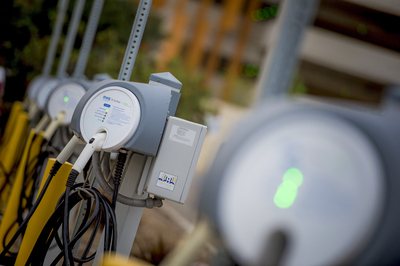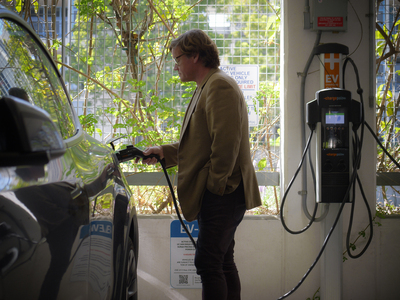How Workplaces Can Better Support the Growing Number of EV Drivers
New computational model developed by UC San Diego reveals human behavior is a key factor in planning workplace EV charging infrastructure
Published Date
Story by:
Media contact:
Share This:
Article Content
A new study from the University of California San Diego has developed an innovative computational tool that can help institutions to better design electric vehicle (EV) charging networks by focusing on how real drivers use their cars and charge them.
The study, published in the journal Renewable Energy, is designed to meet the needs of organizations and firms that are grappling with how to support their employees who are switching to EVs.
“Early EV adopters have tended to be wealthier homeowners who charge their vehicles with private home chargers. But that is not representative of the broader population who may yet switch to an EV,” said Ryan Hanna, assistant research scientist at UC San Diego, who is the co-first author of the paper with Jeff Myers, a research associate with the UC San Diego Deep Decarbonization Initiative. “We have to recognize that many of these drivers are renters, or they live in multi-dwelling units without dedicated parking spaces—people who do not have the ability to install a private home charger. They need other options and most forecasts indicate that workplace charging is going to be the second-most prevalent mode of charging, behind residential charging.”
Hanna and Myers worked with a team of researchers as well as UC San Diego leadership, both of whom oversee the campus’ parking and transportation services, to conduct several studies on the UC San Diego campus, which is home to the largest EV charging network of any academic institution in the Western world.
The team collected anonymized behavioral data from 2023 to 2024, derived from over 800 EV drivers, as well as charging data from 439 charging stations at UC San Diego.

The study improves upon existing computational models, which rely on average data or guesswork. That’s because it incorporates the real reported and observed habits of the drivers that the charging network is designed to serve.
“We have demonstrated that using data from real EV drivers—rather than relying on idealized or regionally-averaged assumptions—can have a significant impact on the optimal design of a charging network,” said Myers, who earned his Master of Public Policy from the UC San Diego School of Global Policy and Strategy in 2023.
EV drivers tend to plug in when they have less than 60% of battery left
For example, the team discovered that existing systems for planning EV infrastructure aren't much informed about how people actually charge their EVs when they are away from home.
At UC San Diego, the team has learned that drivers charge their vehicles more frequently than previously assumed. A key discovery in the study was that drivers have a tendency to charge their cars when they have plenty of battery left—on average, they don’t like to fall below 60%.
With these results in hand, the new study estimates that using individual drivers’ behavior instead of national averages could triple the size of the network needed to fully support workplace charging. This has big implications for the cost and design of workplace charging networks. It also underscores the importance of workplace charging policies and managed charging, which dynamically adjust how the vehicle is charged to meet the needs of both the driver and electric grid. If well implemented, policies and managed charging can encourage more efficient use of the network and push down the higher number of the needed chargers that the study finds.
The researchers plan to make their computational model publicly available so institutions, like universities or businesses, can design charging networks that meet the needs of their employees while keeping costs down.
“The study shows that if workplaces take the time to understand how their employees use their electric cars and charge them, they can create charging networks that are more cost-effective, more efficient and better for the environment,” said Teevrat Garg, an associate professor of economics at the School of Global Policy and Strategy and co-author of the study.

Firms can use the model after collecting their own data with the behavior of EV drivers in their network and feed that information into the model to design a more efficient EV charging network. That includes drivers’ annual driving mileage, commuting mileage, whether or not they have a home charger, how often they charge at work and more. However, firms unable to collect this data can still use the model by inputting behavior data of average EV drivers.
“This kind of tailored design could help organizations provide a better charging experience for their workers, support the shift to electric vehicles and contribute to sustainability goals by reducing emissions from commuting,” said David Victor, a senior author of the study and professor of innovation and public policy at the School of Global Policy and Strategy who also is co-director of the Deep Decarbonization Initiative. “We hope our research, along with UC San Diego’s advanced EV network and ambitious climate goals, serve as a model for other institutions seeking to curb emissions by supporting the growing number of electric vehicles on the road.”
Coauthors of the paper include Josh Kavanagh, assistant vice chancellor of Transportation and Activation at UC San Diego; Jan Kleissl, professor in the Department of Mechanical and Aerospace Engineering at the Jacobs School of Engineering; Sebastian Tebbe, former postdoctoral scholar at the School of Global Policy and Strategy and current professor at the University of Melbourne; and Byron Washom, director of Strategic Energy Initiatives at UC San Diego.
Learn more about research and education at UC San Diego in: Climate Change
Share This:
You May Also Like
Stay in the Know
Keep up with all the latest from UC San Diego. Subscribe to the newsletter today.




